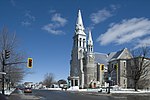Montréal–Mirabel International Airport (IATA: YMX, ICAO: CYMX), originally called Montréal International Airport, widely known as Mirabel and branded as YMX International Aerocity of Mirabel, is a cargo and former international passenger airport in Mirabel, Quebec, Canada, 21 nautical miles (39 km; 24 mi) northwest of Montreal. It opened on October 4, 1975, and the last commercial passenger flight took off on October 31, 2004.
The main role of the airport today is cargo flights, but it is also home to MEDEVAC and general aviation flights, and is a manufacturing base for Bombardier Aviation and Airbus Canada, where final assembly of regional jet (CRJ700, CRJ900 and CRJ1000) aircraft and the Airbus A220 (formerly Bombardier CSeries) is conducted. The former passenger terminal apron is now a racing course, and the terminal building was demolished in 2016.Prior to the demolition of the passenger terminal, Montréal–Mirabel International Airport was classified as an airport of entry (AOE) by Nav Canada and was staffed by the Canada Border Services Agency (CBSA). A smaller AOE is still available at the Hélibellule FBO. It is one of only two non-capital airports with fewer than 200,000 passengers a year to be part of the National Airports System. It was one of two airports in Canada with sufficient right-of-way that can be expanded to accommodate 50 million passengers per year, the other being Toronto Pearson International Airport. A lack of traffic meant that Mirabel was never expanded beyond its first phase. As a result of a controversial expropriation, Mirabel was the largest airport in the world by surface area, with a planned area of 39,660 hectares (396.6 km2; 98,000 acres), until surpassed by King Fahd International Airport in 1999. In 1989, 32,780 hectares (81,000 acres) of the 39,660 hectares (98,000 acres) were deeded back to their original owners.The airport was intended to replace the existing Dorval Airport as the eastern air gateway to Canada. Accordingly, from 1975 to 1997, all international flights to and from Montreal (except for flights to and from the United States) were required to use Mirabel. Mirabel's distant location which had to do with inadequate transport links to urban centres, plus the continued operation of domestic flights from Dorval Airport, made Mirabel very unpopular with travellers and airlines. It did not help that Montreal's economy declined relative to that of Toronto during the 1970s and 1980s, while newer long-range airliners no longer needed to refuel in Montreal prior to trans-Atlantic flights, so passenger levels never approached the levels that had been anticipated. The original plan to eventually close Dorval was discarded, and Mirabel thus turned out to be a white elephant.A decision was made to consolidate Montreal's passenger traffic at Dorval, with scheduled flights and charter flights being shifted in 1997 and 2004, so Mirabel was relegated to the role of a cargo airport. In 2004, Dorval Airport was renamed Montréal–Pierre Elliott Trudeau International Airport, after the Canadian Prime Minister whose government initiated the Mirabel project, the aim of which was to close and replace the Dorval airport. During the 2000s, Dorval was renovated and expanded, which enabled it to handle the passenger levels that the Trudeau government initially claimed would require two airports. Between 2008 and 2018, Mirabel's air traffic more than tripled due to the use of private passenger flights, helicopter flights and flight schools, leading to Aéroports de Montréal renaming the airport to YMX International Aerocity of Mirabel to emphasize it as a business facility.






